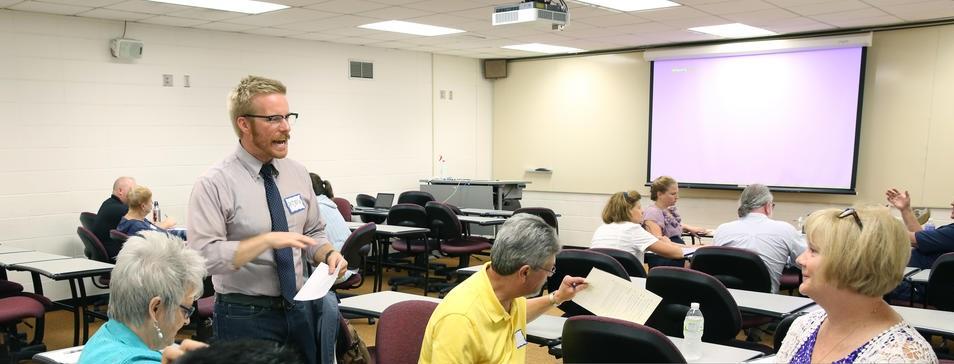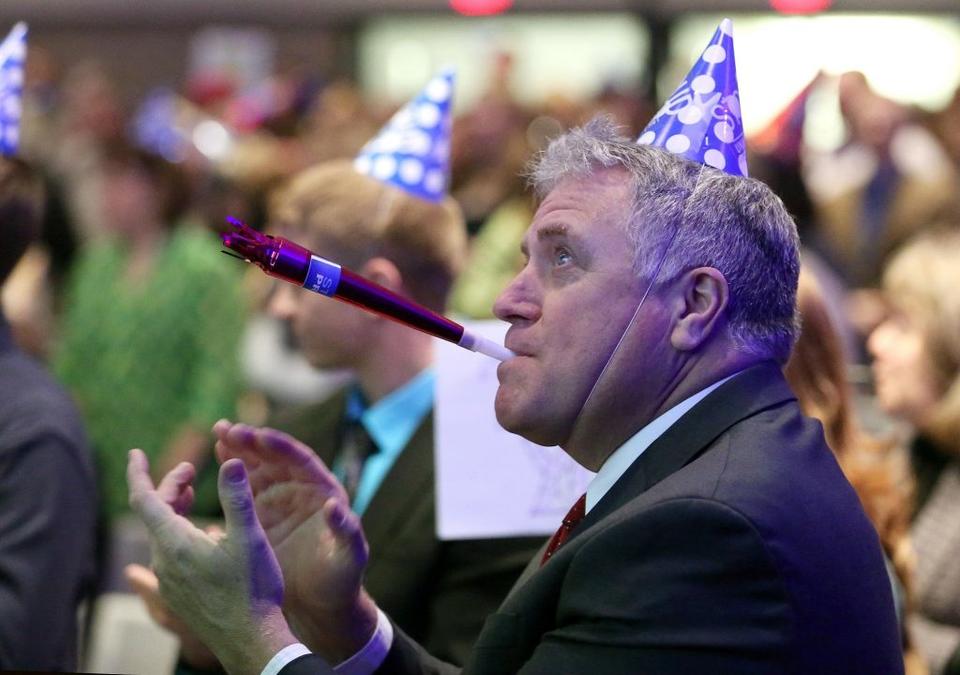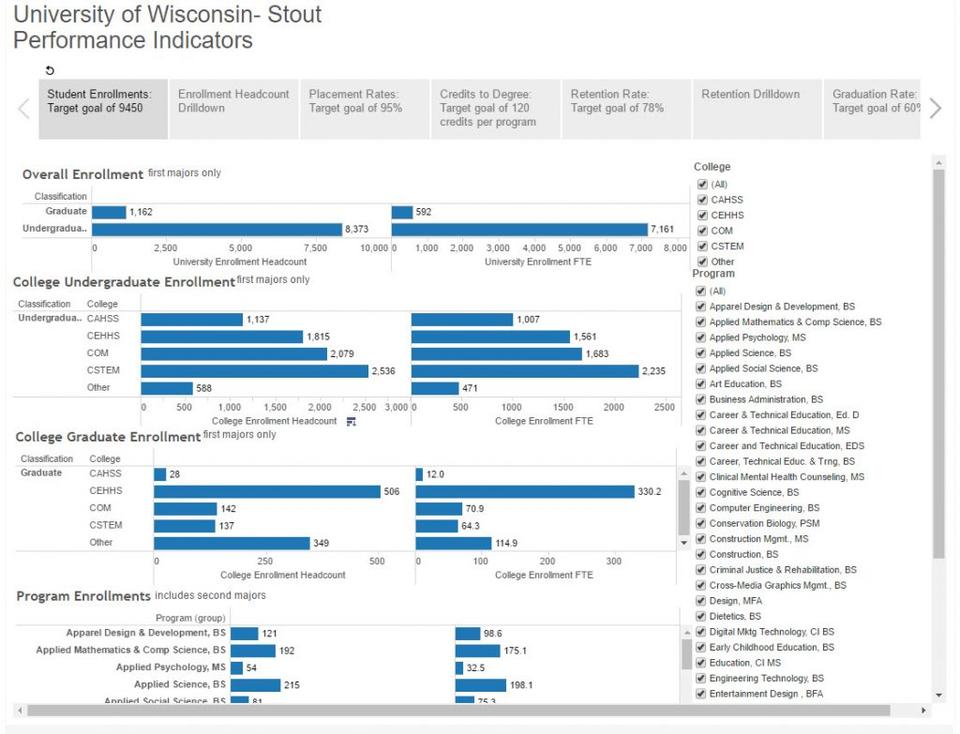Blogrige
The Official Baldrige Blog

UW–Stout faculty and staff members participate in a discussion at an annual event the university hosts to gather feedback on proposed strategic initiatives at the start of the school year.
The University of Wisconsin–Stout earned the first Baldrige Award in higher education in 2001. Dr. Meridith Drzakowski worked at the state university that year as an institutional planner. Today she is the assistant chancellor for planning, assessment, research and quality. Beyond UW–Stout, she is a senior Baldrige examiner, now serving for her sixth consecutive year on the federal program’s Board of Examiners.
To share how UW–Stout continues to improve and innovate to sustain its success, she agreed to provide an update through a group interview of senior leaders. Following are highlights of the recent interview, which included Dr. Bob Meyer, chancellor; Dr. Patrick Guilfoile, provost; and Drzakowski.
What are some key ways in recent years that UW–Stout has used concepts from the Baldrige Excellence Framework (education version) to achieve improvements, innovation, and excellence?
Bob Meyer: I believe that the Baldrige process and Criteria really helped shape the university in terms of its strategic planning process. I think that’s probably one of the most critical tools that we’ve adopted and perfected over time. Pursuing the Baldrige Award encouraged us to refine our strategic planning process and create a process that’s inclusive, responsive, and transparent. By inclusive I mean that it’s designed to engage a broad group of stakeholders to gather ideas on how to look at a future vision for the institution and what continuous-improvement items we need to tackle next. It’s responsive in that if it’s done right, then you should have a plan that is responsive to or reflective of the input you’ve collected and responsive to the needs that were suggested. And it’s transparent from the point of view that we have constant communications. We’ve developed our communication systems that support the planning process, so everyone knows what’s going on and everyone’s aware of it.
Because of that, we have a common road map or a common vision of where we want to go. And when you have that, you have alignment of resources and people so that you can attain outcomes more effectively and quickly even though you invest more time up front doing the planning and gathering the input. … Because you have a buy-in and it’s not solely a top-down process—it’s top-down, bottom-up and you’ve come to a consensus on where you want to go—I think there’s much faster implementation, and the plan is much more embraced or supported. So I think that’s probably one of the most impactful things that the Baldrige process has brought to the university.
I also believe that our decision making and our processes are information- or data-informed. If they work, then we celebrate that they work; if they don’t work, we learn from the fact that they didn’t and we try something else. You don’t have a failure if you’re measuring what’s going on and you learn from it.
UW–Stout’s strategic planning process attracted me to become chancellor because it’s very mature here. If you don’t have a strategic plan process where your action items are actually being worked on and appropriately resourced and you’re seeing movement on them, then you lose momentum.
Meridith Drzakowski: Particularly in the area of strategic planning, I think the Baldrige framework has helped us take some risks in the area of innovation. A specific example would be that at the time that we applied [for the Baldrige Award] in 2001 we had something called Listening Sessions, which we thought were innovative [then]. And that was a series of eight or nine separate sessions, an hour in length each, where we would share with the campus some of the major initiatives that we were hoping to implement and ask for feedback.
We got some good information from that process, but there were also a number of concerns, in particular, a lot of the same people would be showing up at the events, a limited number of people would be comfortable speaking up, and there was a perception by some people that they were there to be listeners rather than contributors.
So we … completely restructured the format. So now as part of the “Welcome Back” events, we have what’s called an Engagement Session, where we first all get together in one central location, … we present these major ideas to the campus, and then we split into 35 separate rooms. So all faculty and staff are randomly assigned to these rooms where they have a facilitated discussion about the proposed initiatives, and there’s a facilitator and note taker in every room. We get hundreds of pages of comments back, which are reviewed by our Strategic Planning Group and then used to make changes and improvements to those initiatives.
Students are invited as well, but it’s primarily our faculty and staff who participate. … Over half of our faculty and staff show up for the event, which starts at 8 a.m. and ends with lunch. …
A second innovative example (again tied to our planning process) would be something called the “You Said, We Did,” [which is] really tied to the learning aspect of the Baldrige process. We have, since forever, been listening to feedback from the campus and taking action based on that. But we came to learn that a lot of people were not making the connection between the feedback that they provided and the actions that we were taking, and we learned that we needed to be very intentional about that. So we started with these “You Said, We Did” sessions, which happen during the “Welcome Back” for the beginning of the second semester and where we have people who had a role in these initiatives present. And what they present are examples of specific feedback provided during the Engagement Sessions, … specific actions taken based on that feedback, and … the people who made it possible. We started out having it be a report-out like that, but over time we wanted to make it fun and engaging and more of a celebratory atmosphere.
Drzakowski then described how the university has made the annual event more celebratory in recent years through adjustments such as ordering party hats and noise makers for the presenters and audience at the January 2015 session, as well as encouraging sunglasses to be worn widely and arranging to have guitar music played on stage at the January 2016 event.
It’s really turned into a celebratory event where we really thank the campus for what they’ve provided and demonstrate that we’re using their feedback.

Patrick Guilfoile: I’m still [relatively new here] … so I’m seeing things through different eyes. … but as I’ve been on campus, I’ve asked a lot of questions about why we do things; I almost never remember hearing “because that’s the way we’ve always done them.” So I’ve really seen an openness on campus—maybe it would fall under the [Baldrige core value] of managing for innovation—to explore different ways of doing things. And that’s really impressed me during my time on campus here.
What differences have you observed between how your institution focuses on continuous improvement (or performance excellence), in comparison to practices at other educational institutions?
Meyer: Celebration is important. A comment about continuous improvement is that you’re always looking at what little foible is wrong that we need to improve. So you can come away from that thinking that we’re always criticizing the institution. But that’s really not true.
Our university culture embraces the idea of change and how we can do something better, but we want to keep it positive. Celebrating success is really important because otherwise people think, “This whole continuous improvement process seems negative because you’re being critical of how we do things.”
Guilfoile: As an example of a unique process at UW–Stout, Guilfoile first described a rigorous and innovative data-collection, measurement, and review process, overseen by Drzakowski’s office, that aims to verify and ensure that tuition dollars allocated for student services such as tutoring centers are having the intended effect.
In my own experience elsewhere, I hadn’t seen that kind of attention to collecting the right kind of information to validate whether or not the money is being spent in a way that really is being helpful.
[As another example,] the program review process on campus is very detailed and very in-depth and that’s been helpful to provide administrators with information on resources needed… in the current more resource-constrained environment. … There’s been a real openness on campus to have discussions and develop processes … to incorporate elements that can be controversial [such as looking at costs and revenue generated by programs] in our longstanding program review process. … From the perspective of being a new person on campus, I’ve been very impressed with how quickly people here move forward with that even though there are controversial aspects and really try to work through and come up with the best solution. So that’s another example related to differences with other institutions.
Would you please share details about your recent initiative to develop and implement a cascading scorecard for the organization?
Drzakowski: Category 4 [the Baldrige Criteria section that assesses measurement, analysis, and knowledge management] was our lowest-scoring category in the Baldrige Award process [when UW–Stout applied for and received the award]. … So we’ve really spent a lot of time working on trying to improve there. And I think our most significant issues … were in the areas of deployment and integration.
We have metrics that we use as part of our strategic planning process that we’re regularly monitoring, but there was room for improvement in terms of how many people were looking at them, what processes they were integrated into, and at what levels of the organization they were being used.
Our strategic plans are five-year plans, and at the beginning of each plan, we develop what we call performance indicators, which are a small set of metrics that we use to assess the overall success of our strategic plan. So it’s about 25 metrics that we develop every five years, and they’re reviewed regularly by our Strategic Planning Group. And we do have many examples of how we used those results to develop initiatives at the university level, but fewer initiatives at lower levels of the organization. And primarily we felt that was because we weren’t systematically presenting data segmented down to the major units, departments, and program levels.
So the first step we took was to create what we called Program Facts, which were static dashboards [showing for a point in time] how the college was performing on metrics that could be drilled down to the program level. From that we’ve migrated to what we have now with the cascading scorecards, an interactive dashboard that has our performance indicators on it at the university level, and you can drill down to the college, unit, department, and academic program levels. And there’s additional segmentation by gender, student level, minority status, and such.

That has helped us in the conversations with the Strategic Planning Group to see where it is that we’re doing well and where it is that we can improve, and I think that it has led to more targeted initiatives. But where we still see room for improvement is better integrating these into existing processes on campus. So what we’re working on now is integrating these into processes for academic program review [etc.]. So we’re intentionally integrating these into those processes so that there will be more outcomes ... both in the area of opportunities for improvement as well as better sharing of best practices.
Guilfoile: Meridith has done a really good job of making sure that we’re not tracking so many different things that it’s impossible to manage all of those. In conversations I’ve had with her, she’s been reluctant, for very good reason, to add something without taking something away. That kind of discipline has been very helpful to ensure that we’re not overwhelming people with an enormous number of things to track.
Could you please give key reasons that you believe other organizations in the education sector, particularly in higher education today, could benefit from using the Baldrige Excellence Framework (including the Education Criteria for Performance Excellence)?
Meyer: I think the great value of the Baldrige framework is that it gives you a structure under which to plan and implement a vision forward, or a future state, and you can do it in a way that engages both external and internal stakeholders.
Meyer then explained that external stakeholders are included in UW–Stout’s visioning sessions that initiate the five-year cycle for creating new strategic plans.
The significant engagement that we have starts, first of all, with the Strategic Planning Group that helps facilitate it. This group deliberately has many employee types as members, and the Engagement Process literally involves everyone across the institution. One of the reasons I think that’s a helpful model is that engagement creates a common road map that everybody can rally around and understand. If you have that level of engagement up front creating the vision and the road map, you’re going to have much better alignment when you go to deploy and implement it. The process allows for all of our employees to be working in the same direction.
With the level of engagement that results, there’s ownership on the part of the employees. … Consequently, they are stewards of the road map, and you can feel that in the culture. In fact, it really feels good when you work here and you don’t have to push the staff at all; in many ways, they’re pulling the leadership along with them.
Drzakowski: Prior to our adopting the Baldrige framework, we were tracking too many metrics—well over one hundred. … the Baldrige framework has helped us—and can help other organizations—to identify what is most important for the organization. Drzakowski added that she considers this critically important in higher education given the trend toward an increasing number of accountability processes, for example, with state and national scorecards. Meyer: Meyer next described how UW–Stout has used its strong strategic planning process to help it effectively manage recent state funding cuts that resulted in a 10.4 percent reduction in the university’s discretionary operating budget.
At the previous institution where I worked and also previously when I was a dean at UW–Stout, we implemented funding reductions across the board as a percentage. … This time around, we really wanted to be strategic about how we navigated our reductions.
In the same way that we do strategic planning, we had the same levels of engagement in terms of how we looked at creating our reductions. It’s not as much fun as thinking big about what your future looks like. But I think it’s really important because what we tried to do was protect our strategic plan and associated action plans. We came up with a set of principles for how to do that. So we did not do across-the-board cuts. We did our cuts strategically. We actually downsized a lot of our administration and tried to keep the instructional area held harmless as much as we could. So I’m proud of that. In addition to using strategic planning to grow, we’ve now used it as way to shrink a little bit, too.
Drzakowski: I think in terms of the Baldrige framework that the Organizational Profile really can help organizations with what Bob is talking about, to identify what’s most important and be able to handle those kinds of reductions in strategic ways.
Would you please suggest a few tips for using the Baldrige framework to support high performance across your organization?
Drzakowski:
- Follow the Baldrige Core Values, particularly valuing people and managing for innovation. In the area of valuing people, establishing trust is so critical for us, and I think it’s the Baldrige framework that helps us do that. We just finished an accreditation visit; we had a team here, and they [said] it was evident that the campus had trust in the leaders, and they asked what our magic formula is for accomplishing that. And I think it’s about having the difficult conversations regularly and whenever issues come up.
Meyer:
- Communicate! If you think you’ve gotten to the point of communicating enough, you’re in trouble. I think one of the best things that Meridith did was set up these “You Said, We Did” sessions. It’s really important to show your stakeholders the evidence that you’ve used their feedback.
Drzakowski:
- Thank people for their role in your engagement and improvement processes. This reinforces employees’ engagement and ownership in continuous improvement. Even those who filled out a survey are asked to stand and be recognized at the “You Said, We Did” sessions for contributing their input.
Guilfoile:
- Build trust [through the above actions]. When people trust one other, things can happen more expeditiously. I want to reiterate the importance of that principle.
About the author
Related Posts
Comments
- Reply





